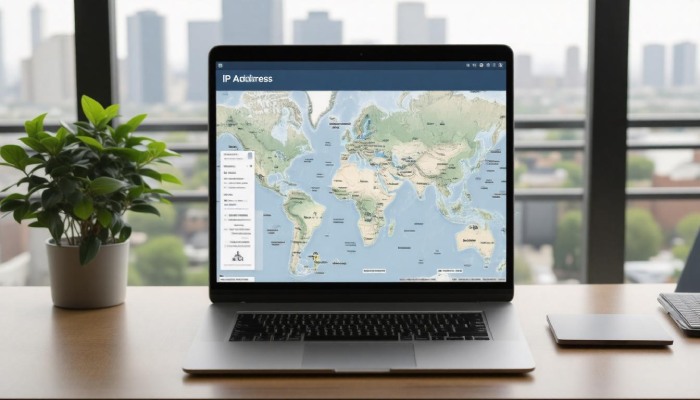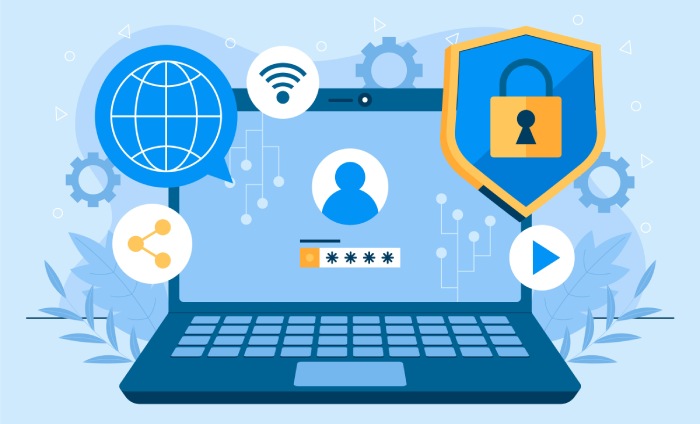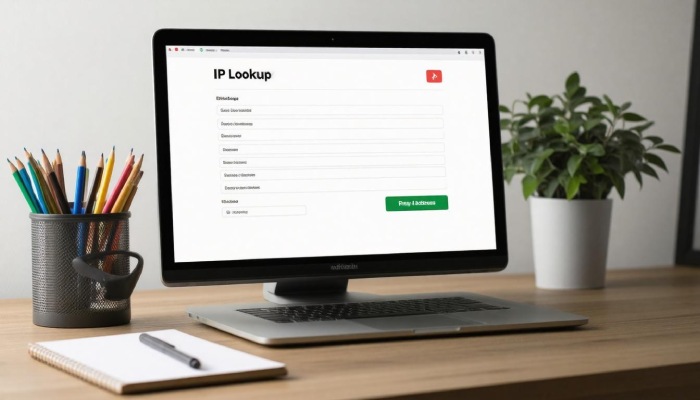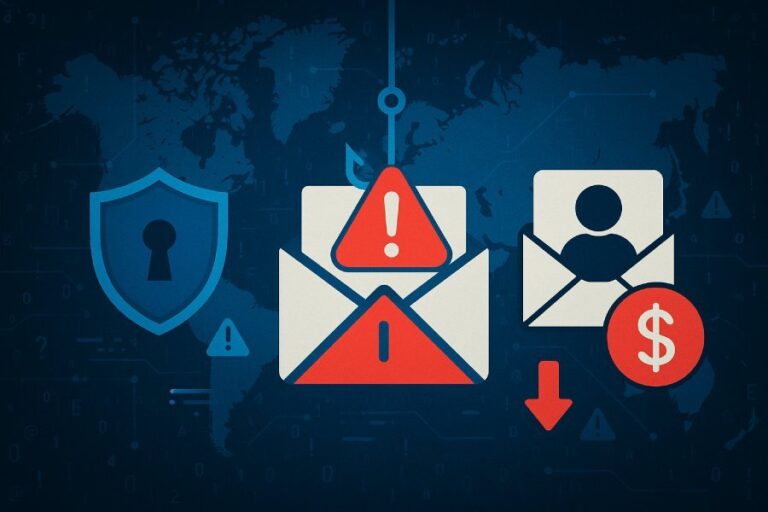In today’s digital landscape, your IP address is more than just a line of numbers; it’s like a digital identity that reveals where you are and who you’re with online. Have you ever wondered how websites automatically suggest content based on your location, or what happens when you browse the internet? Understanding your IP address can help unravel these mysteries and even enhance your online security.
But it’s not just about knowing where you connect from; it’s about the implications this tiny piece of data can have on your privacy and digital activities. Let’s dive into the fascinating world of IP addresses to see how they work, the differences between IPv4 and IPv6, and what you can discover through an IP lookup.
You can perform an IPv4 lookup using various online tools, such as IPLocation.io, which allows you to enter an IPv4 address and retrieve information including the geographical location, ISP details, and organization associated with it. This provides valuable data that can enhance your understanding of online activities and network security.
How IP Addresses Work
Identification and Routing
An IP address identifies a device on the internet, acting much like a unique license plate for every vehicle on the road. It not only marks the device’s presence but also plays a crucial role in directing the flow of data from one point to another. Think of it as an intricate web where each thread must connect properly for messages to travel seamlessly.
Just as a letter needs the right postal address to find its way home, data packets need these unique identifiers to arrive at their intended destination.
If the address is incorrect, even the most dedicated postman can’t deliver it! In the case of data transmission, improperly addressed packets are discarded, creating frustration and inefficiency.
Composition of IP Addresses
To truly understand this addressing system, we need to look at the structure of IP addresses themselves. An IPv4 address is composed of four sets of numbers, each separated by periods. Each number ranges from 0 to 255, giving us familiar examples like 192.168.1.1. This simple format was widely used historically because it was easy to remember and implement.

In contrast, IPv6 addresses take on a more complex appearance due to their length and composition. These addresses consist of eight groups of hexadecimal digits (numbers and letters), such as 2001:0db8:85a3:0000:0000:8a2e:0370:7334. As we approach the limits of available IPv4 addresses due to the exponential surge in internet-connected devices, the shift towards IPv6 is essential.
To illustrate the difference, consider this:
| Address Type | Format Example | Length | Total Addresses |
| IPv4 | 192.168.1.1 | 32 bits | Approximately 4.3 billion |
| IPv6 | 2001:0db8:85a3:0000:0000:8a2e:0370:7334 | 128 bits | Virtually limitless (about 340 undecillion) |
Grasping these foundational aspects of IP addresses leads us to explore further distinctions that will enhance our understanding of internet infrastructure and its implications for users today.
Difference Between IPv4 and IPv6
Address Length
At the heart of the difference between IPv4 and IPv6 lies their address frameworks.
IPv4, with its 32-bit addressing scheme, can offer approximately 4.3 billion unique IP addresses. This may seem like a large number, but as we have seen in recent years—especially with the explosion of internet-connected devices—it simply isn’t enough.
Enter IPv6, which expands this significantly using its 128-bit address scheme. With IPv6, we are talking about an astounding 340 undecillion possible addresses (340 followed by 36 zeros). This massive increase ensures that even as our world becomes more connected, there will be plenty of addresses to go around.
However, it’s essential to also consider how these new structures impact our internet experience.
Improvements and Benefits
Beyond the sheer quantity of addresses, IPv6 brings several crucial improvements that enhance connectivity and network management. One notable feature is its ability to simplify routing and improve autoconfiguration capabilities.
Under IPv4, sharing a single IP address among multiple devices required an added layer of complexity known as Network Address Translation (NAT). This makes setting up home or office networks more cumbersome and can introduce complications when connecting devices to the internet.

With IPv6, NAT becomes obsolete because each device can have its own unique IP address directly associated with it, streamlining communication across networks. This enhances performance and reduces potential bottlenecks on data traffic.
Think of upgrading to IPv6 as moving from a crowded two-lane highway to a vast superhighway designed for smooth sailing. With more lanes available to accommodate increasing traffic without congestion, data packets can travel faster and more reliably.
Furthermore, there are security advantages that come into play with the adoption of IPv6.
Security Improvements
One of the noteworthy advancements in IPv6 is the built-in support for IPsec, a suite designed to secure internet protocol communications by authenticating and encrypting each IP packet. While IPsec was optional for IPv4, it is integral to the design of IPv6.
This change inherently raises the bar for online security as data transmitted over networks benefits from encryption right at the transmission source. By incorporating these security measures into its framework from the get-go, IPv6 not only provides better protection but also encourages developers and organizations to prioritize security measures throughout their infrastructure.
Boost your email security and protect your digital identity with our automatic SPF flattening tool, along with seamless SPF, DKIM, and DMARC setup—perfectly complementing your understanding of IP-based privacy and online protection.
As we explore further, it’s worthwhile to understand what an IP lookup entails and how it plays a critical role in navigating our digital lives.
What is an IP Lookup?
An IP lookup refers to the process of retrieving specific details about a given IP address. This isn’t just some technical jargon; it’s a straightforward way for users to discover useful information that can enhance their online experience.
For instance, when you input an IP address into a lookup tool, you’ll typically receive data such as geographical location, the internet service provider (ISP), and even the hostname associated with that address. Picture this: you enter an IP address and, within seconds, see that it’s affiliated with a customer using Comcast in Chicago. Suddenly, that string of numbers feels more personal and accessible.
But why would anyone want to perform an IP lookup? The answers lie in the wide range of applications these tools offer.
When you participate in online activities—whether you’re streaming videos, gaming, or simply browsing—you might feel vulnerable. Understanding where your connection comes from helps demystify these interactions. By knowing which ISP is tied to your IP or where your data is routed, you gain peace of mind regarding both security and performance. Moreover, businesses utilize IP lookup services for various reasons like customer profiling or improving targeted advertisements based on geographical data.
In essence, IP lookups empower you with knowledge, turning abstract numbers into meaningful insights about your digital interactions.
You’re probably curious about how reliable this information is and how accurate it can be when identifying details linked to an IP address.
It’s important to note that while IP lookups provide compelling information, their accuracy can sometimes vary. You may find that these tools pinpoint your city rather than your exact physical location. For example, one user mentioned that their indicated location was over 100 kilometers away from their true position. Such discrepancies suggest that while these lookups offer valuable general insights into geographic data, they shouldn’t be relied upon as definitive identifiers.

Keep this in mind: the reliability of IP lookup results can depend on various factors such as:
- The database being utilized by the lookup tool
- How comprehensive their geo-location datasets are
- Regional network configurations
This brings us into the realm of privacy concerns and practicalities regarding how individuals use this technology.
Beyond merely tracking geographical data, understanding an IP address also touches on issues such as online surveillance and personal privacy. Individuals may seek methods to mask their IP or employ VPNs (Virtual Private Networks) to enhance anonymity while navigating the web. Consequently, discussions surrounding the implications of mapping out personal data through IP addresses continue to flourish within community forums such as Reddit, illustrating a widespread public curiosity regarding how to manage one’s digital footprint effectively.
As we explore further, there are various tools available that help individuals find detailed information related to their IP addresses and enhance their online understanding.
Common Tools for Finding IP Information
There are a variety of tools designed to help you obtain valuable details from an IP address, each serving a different purpose and audience. Some are incredibly user-friendly, making them accessible for beginners who want quick results, while others provide deeper insights ideal for professionals in IT and cybersecurity.
Popular Online Tools
- IPLocation.io: This platform excels at offering detailed geo-location data, allowing users to visualize exactly where an IP address is located on a map. It is particularly helpful when trying to ascertain not just the country or region but also the city associated with an IP address, making it useful for businesses wanting to localize their services or marketing efforts.
- WhatIsMyIP.com: Known for its simplicity, this site focuses on delivering your ISP information alongside relevant network details. It can be particularly handy when you need to understand how your device connects to the internet or check your own IP address.
- IPinfo.io: This tool provides a wealth of information, including organizational details tied to the IP and even threat assessments. Businesses will find this beneficial as they seek to filter out fraudulent traffic and protect sensitive data.

While those online platforms are fantastic for quick lookups, sometimes having tools built right into your computer can streamline the process even further.
In-Built Command-Line Tools
These tools might not boast flashy interfaces, but they offer essential functionality directly from your command line. Simple commands like ping, tracert (or traceroute), and nslookup are regularly utilized by network administrators for basic tasks.
Using ping, for example, allows you to test connectivity between your machine and an external server. When you enter the command along with an IP address or hostname, you’ll receive feedback about packet loss and response times—vital metrics that help diagnose network issues.
The tracert command uncovers the path that data packets take to reach a destination. This can unveil any bottlenecks or failures along that route—information invaluable when examining potential points of failure within larger networks.
Finally, nslookup helps you gather DNS-related info about an IP address. This is particularly useful in identifying whether an IP resolves to a particular domain name, aiding in ensuring that web traffic flows smoothly.
Knowledge of these tools is integral not only for troubleshooting but also for enhancing overall cybersecurity measures as they empower users to investigate and rectify potential vulnerabilities effectively.
With a firm grasp of both online tools and command-line options at your disposal, you’re well-prepared to explore the practical aspects of conducting thorough IP lookups.
Step-by-Step Guide to Performing an IP Lookup
Step I – Select a Tool
Choosing the right IP lookup tool is your first step towards uncovering valuable information. Websites like IPLocation.io and IPinfo.io have solid reputations for accuracy and user-friendliness. When you access these platforms, they typically display their identity clearly, so you know you’re in the right place.
It’s as though you’re entering a digital library, each shelf filled with insights waiting at your fingertips. As you browse your options, keep an eye out for tools that offer detailed reports—this indicates a comprehensive database that’ll provide geographic data as well as ISP information and latitude and longitude coordinates.
Once you’ve picked a tool, it’s time to dig deeper into the information you want to find.
Step II – Enter the IP Address
With your chosen lookup service open, the next task involves typing or pasting the relevant IP address into the designated input field. This field typically has clear labeling such as “Enter IP address,” making it simple to navigate. It’s important to double-check this entry; any typos could lead you to misleading results.
Imagine trying to locate a book in a library using half of the title; it just won’t get you where you want to go.
After entering the address, let’s take another crucial step: initiating the search.
Step III – Initiate the Search
Clicking on the search or lookup button initiates the process. At this point, the tool begins compiling data linked to that specific IP address—like a detective piecing together clues from a case file. You’ll soon see details like geographical location (city, region, country), Internet Service Provider (ISP), and even some intriguing additional information such as the anonymity level of that IP address.
It’s worthwhile to review all results thoroughly for accuracy and completeness. Many people may believe their approximate location displayed by an IP lookup is their precise physical address; however, discrepancies can exist, with results often reflecting nearby major cities instead of exact locations. Some users have noted online instances where their addresses were registered over 100 kilometers away!

Understanding how to use these tools not only enhances your knowledge about personal details based on your IP but also prepares you for more significant questions related to privacy and online security. This awareness opens up new avenues for engagement and exploration in managing your digital footprint.
Practical Uses of IP Lookups
IP lookups play several crucial roles that go beyond mere curiosity about one’s online location. One significant application is enhancing online security. Businesses leverage these tools to safeguard their digital environments by monitoring user activity more effectively. For instance, if a company detects repeated login attempts from an unfamiliar IP address, it’s a warning sign of a potential security breach. By quickly identifying these suspicious behaviors, businesses can take precautionary measures, such as blocking access from that region or implementing multi-factor authentication to bolster their defenses.
The power of real-time alerts based on IP lookup data allows organizations to react swiftly and safeguard sensitive information.
Beyond enhancing security, another practical use lies in content personalization. Streaming services like Netflix and YouTube have revolutionized how we consume media by utilizing IP lookups to tailor content recommendations to users’ regional preferences. This isn’t just about making user experiences more enjoyable; it’s also necessary for compliance with regional laws and licensing agreements.
When you log into your account, the service recognizes your geographic location and adjusts available content accordingly. This ensures both legality and improved user satisfaction. Have you ever wondered why certain movies are unavailable in your country? That’s where IP lookups come into play, enabling these platforms to adhere to complex licensing agreements and restrictions.
However, while these uses are undeniably beneficial, they also bring forth significant privacy concerns that users must remain aware of.
The increasing reliance on IP lookups raises questions about how much information is being collected and what it means for personal privacy. As users become more aware of potential tracking, tools like Virtual Private Networks (VPNs) have surged in popularity. VPNs allow individuals to mask their real IP address, making it harder for websites and services to track their activities.
In fact, recent statistics indicate that around 60% of internet users express concerns about their IP being tracked, leading to a sharp rise in VPN subscriptions—an increase of 30% noted in 2023 alone.
As we see, while IP lookups can significantly enhance security and improve content accessibility, they open discussions on personal data exposure. It’s essential for users to balance leveraging these benefits with an understanding of the implications regarding online anonymity.
This intersection of convenience and caution sets the stage for an important conversation about maintaining safety in our digital landscapes, emphasizing the importance of protecting personal data while navigating online spaces.
Privacy and Security Concerns
Despite the functionality that comes with IP lookups, they raise significant privacy concerns. An IP address acts like a digital fingerprint, unique to each device connected to the internet. This means that whenever you browse a website or stream a movie, your IP address reveals your location and internet service provider (ISP).
Imagine sitting in your favorite café, sipping coffee while working on your laptop, completely unaware that anyone with access to your IP can pinpoint your geographic location. This not only puts your physical safety at risk but also opens the door for various cyber threats.
According to a 2021 report by the Electronic Frontier Foundation, 67% of internet users feel uneasy about their online activities being tracked via their IP address. It’s no small wonder why this fear exists; exposing your IP address gives third parties—malicious users or advertisers alike—a direct line to you. They can potentially execute cyberattacks or track your browsing habits to bombard you with targeted advertisements.
Furthermore, while an IP address can theoretically reveal user locations, it’s essential to recognize that ISPs have the capability to disclose user details under legal pressure. So not only is there a risk of being monetized through data collection, but there’s also a chance that sensitive information could be handed over to authorities.
As we further explore these security concerns surrounding IP exposure, it becomes clear that strengthening our online defenses is more important than ever.
Protection Measures
One highly effective strategy for protecting your online identity is using a Virtual Private Network (VPN). A VPN masks your real IP address and encrypts your web traffic, creating a shield against prying eyes. With top-tier VPN services like NordVPN and Surfshark available today, safeguarding your online activity has never been easier. By routing your internet connection through secure servers located in different regions or countries, you obscure your true location while adding another layer of security to your data.
Ever wondered why you’re seeing ads from local businesses even when browsing anonymously? That’s your IP address giving away more than you think! The personalization of advertisements based on location can feel both convenient and intrusive simultaneously. Many users often fail to grasp how much influence their exposed IP address can wield over their digital experiences.
Next time you’re wondering why it’s so hard to escape those local pizza shop ads despite supposedly incognito browsing, remember that an unmasked IP can be more revealing than you’d expect! Implementing protective measures helps ensure our browsing habits remain just that—our habits—free from disruption or unwanted intrusion.
By taking such precautions seriously and understanding the importance of maintaining digital privacy through tools like VPNs, individuals can gain control of their online identity while enjoying all the benefits the Internet has to offer.
Ultimately, staying informed and proactive in protecting your online presence not only enhances personal security but also contributes significantly to a safer internet environment for everyone.
What tools or websites are the most reliable for performing an IPv4 address lookup?
The most reliable tools for performing an IPv4 address lookup include websites like IPinfo, WhatIsMyIP, and GeoIP. These platforms provide accurate geolocation data, ISP information, and more, making them invaluable for network administrators and security professionals. According to various user reviews and industry analyses, IPinfo consistently ranks high in accuracy, with over 90% of users reporting satisfaction with its detailed insights and user-friendly interface.

What privacy concerns should I be aware of when looking up someone’s IPv4 address?
When looking up someone’s IPv4 address, be aware of privacy concerns such as data misuse and potential breaches of confidentiality. IP addresses can reveal a user’s approximate geographical location and online activities, leading to risks like stalking or targeted advertising. According to a 2022 report, over 70% of individuals expressed concerns about their personal information being exposed through IP tracking. Always ensure that your actions adhere to ethical standards and legal regulations, as unauthorized access to personal information can lead to serious consequences.
What detailed information can I obtain from an IPv4 address lookup (e.g., location, ISP)?
An IPv4 address lookup can yield a variety of detailed information, including the approximate geographical location (city, state, and country), the Internet Service Provider (ISP) associated with that IP, and sometimes additional data such as latitude and longitude coordinates. This data is essential for network diagnostics, as it helps identify the origin of online traffic and user patterns. For instance, studies show that nearly 90% of businesses use IP geolocation to enhance service delivery and target advertising strategies based on user locations.
How does an IPv4 address differ from an IPv6 address, and why might this matter for lookups?
An IPv4 address consists of four octets, allowing for about 4.3 billion unique addresses (2^32), whereas IPv6 uses eight groups of hexadecimal digits, accommodating an astonishing 340 undecillion addresses (2^128). This significant expansion in address space is crucial as the internet continues to grow; IPv4 addresses are becoming scarce due to the increasing number of devices online. For IP lookups, understanding the differences matters because tools and methods vary between the two protocols—IPv6 may provide more detailed location information thanks to its hierarchical addressing structure, improving geographical accuracy for users and businesses alike.
How can I identify the owner or organization associated with a given IPv4 address?
To identify the owner or organization associated with a given IPv4 address, you can use a WHOIS lookup service, which provides details such as the organization name, contact information, and the IP address’s registration details. These databases are maintained by regional internet registries like ARIN, RIPE, or APNIC. According to statistics, nearly 80% of IP addresses are registered to specific organizations, making WHOIS inquiries an effective tool for this purpose. This process not only reveals ownership but can also indicate geographical usage patterns tied to the IP in question.






